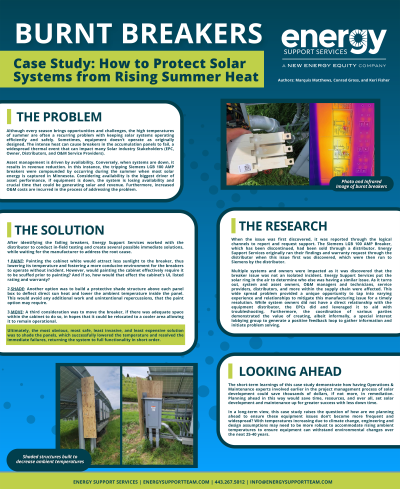Back

Finance and Asset Management
Burnt Breakers: A Case Study on How to Protect Solar Systems from Rising Summer Heat
Tuesday, September 12, 2023
4:30 PM - 5:30 PM PDT
Location: Poster Area, Booth #11024, Level 1, Venetian Expo Hall

.jpg)
Marquis Matthews, n/a (he/him/his)
Vice President of Operations
Energy Support Services
Annapolis, Maryland, United States
Submitter(s)
High summer temperatures are often a recurring problem with maintaining safe and efficient solar systems. Sometimes, equipment doesn’t operate as originally designed. Intense heat can cause breakers in the accumulation panels to fail, a widespread thermal event that impacts many Solar industry Stakeholders (EPC, Owner, Distributors, and O&M Service Providers).
Asset management is driven by availability. When systems are down, it results in revenue reduction. In this instance, tripping breakers were compounded by occurring during the summer when most solar energy is captured in Minnesota. If equipment is down, the system loses availability and crucial time generating solar and revenue. Increased O&M costs are incurred in the process of addressing the problem.
Because the breaker issue was not an isolated incident, system and asset owners, O&M managers and technicians, service providers, distributors, and more within the supply chain were affected. This provided a unique opportunity to leverage varying experience and relationships to mitigate this manufacturing issue for a timely resolution.
Energy Support Services worked with the distributor to create two possible immediate solutions, while awaiting the manufacturer to address the root cause. First, painting the cabinet white to attract less sunlight, thus lowering its temperature and fostering a more conducive environment for the breakers to operate without incident. Second, building a protective shade structure above each panel box to deflect direct sun heat and lower the ambient temperature inside the panel.
Ultimately, the safest, most obvious, least invasive, and least expensive solution was to shade the panels, which successfully lowered the temperature, resolved the immediate failures, and returned the system to full functionality in short order.
With temperatures increasing due to climate change, engineering and design assumptions may need to be more robust to accommodate rising ambient temperatures to ensure equipment can withstand environmental changes over the next 25-40 years.
Asset management is driven by availability. When systems are down, it results in revenue reduction. In this instance, tripping breakers were compounded by occurring during the summer when most solar energy is captured in Minnesota. If equipment is down, the system loses availability and crucial time generating solar and revenue. Increased O&M costs are incurred in the process of addressing the problem.
Because the breaker issue was not an isolated incident, system and asset owners, O&M managers and technicians, service providers, distributors, and more within the supply chain were affected. This provided a unique opportunity to leverage varying experience and relationships to mitigate this manufacturing issue for a timely resolution.
Energy Support Services worked with the distributor to create two possible immediate solutions, while awaiting the manufacturer to address the root cause. First, painting the cabinet white to attract less sunlight, thus lowering its temperature and fostering a more conducive environment for the breakers to operate without incident. Second, building a protective shade structure above each panel box to deflect direct sun heat and lower the ambient temperature inside the panel.
Ultimately, the safest, most obvious, least invasive, and least expensive solution was to shade the panels, which successfully lowered the temperature, resolved the immediate failures, and returned the system to full functionality in short order.
With temperatures increasing due to climate change, engineering and design assumptions may need to be more robust to accommodate rising ambient temperatures to ensure equipment can withstand environmental changes over the next 25-40 years.
